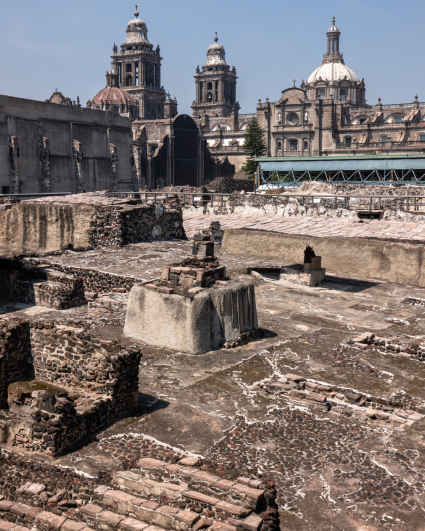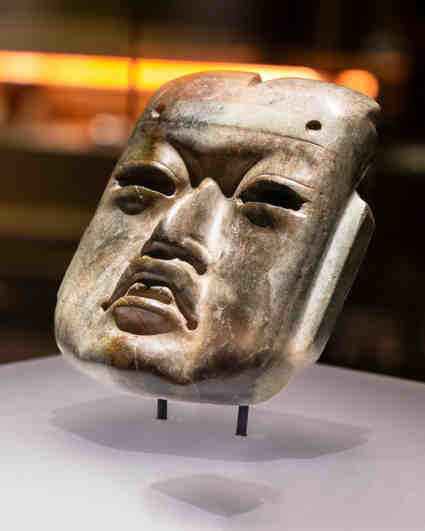Highlights
Ruins of the Aztec Capital
Tenochtitlan, the capital of the Aztecs (a pre-Hispanic culture also known as the Mexica), was one of the world’s great metropolises, a place of wonder for the Spanish conquistadors when they first arrived in 1519.
The 45-meter high pyramid of the Templo Mayor marked the center of the city as well as the central axis of the Aztec religion.
The Spanish conquest wrought vast destruction on Tenochtitlan. The Templo Mayor was leveled to the ground, with stone from the pyramid used to construct the first buildings of the new colonial capital above the ruins of the Aztec city.
But in recent decades, painstaking archaeological excavations below the center of Mexico City have uncovered the remnants of the Templo Mayor. These reveal a glimpse of the great Aztec city’s ceremonial center that once stood on the same ground occupied by the Centro Histórico today.

The Museum
The Aztecs were dedicated collectors of art.
As their armies conquered vast swathes of territory across Mexico, they brought back to Tenochtitlan a remarkable collection of works produced by the communities that they conquered.
And the Aztecs were themselves great archaeologists who were fascinated by the indigenous cultures that preceded them. They collected relics dating as far back as the Olmec, Teotihuacan and Toltec eras.
Many thousands of these artifacts were taken to the Templo Mayor to be presented as offerings to the gods. The quality of these offerings is so immense that Tenochtitlan could well be considered the global art capital of its time.
Buried below the Centro Historico, archaeologists have in recent decades discovered a wealth of art and artifacts. Many of these are now on display in the expansive Templo Mayor Museum, which offers a fascinating insight into Mexico’s pre-Columbian civilizations.

Tickets & Opening Hours
| Monday: | Closed | ||
|---|---|---|---|
| Tuesday to Sunday: | 09:00 AM | — |
05:00 PM |
| Tickets (Mexican Pesos): | $ 95 |
|---|---|
| Approx cost in US dollars: | $ 5.00 |
The main entrance is at basement level, below the plaza on the eastern side of the Metropolitan Cathedral. Head down the ramp and through the main doors. There is a security checkpoint at the main entrance. If you have any bags, these must be left at the bag storage desk in the main entrance hallway.
Tickets can be purchased from desk in the main entrance hallway before entering the museum.
Tickets can be purchased online from:
Instituto Nacional de Antropología e Historia (INAH)
Select ‘Museo y Zona Arqueológica de Templo Mayor’
Getting There
Turibus is a convenient way to tour all of Mexico City’s major sights in a short time. Open-top buses offer great views of the city, while the driver takes care of navigating the city’s chaotic streets.
The Turibus Centro Historico route stops in the Zocalo next to the Metropolitan Cathedral, which is just a few minutes walk from the Templo Mayor.
The circuit also covers many of the city’s major points of interest, including:
- Palacio de Bellas Artes
- National Museum of Anthropology
- The Angel of Independence & Avenida Paseo de la Reforma
- Monument to the Revolution
Tickets and schedules are available online from Viator and Get My Guide
Situated in the heart of the Centro Historico next to the Zócalo central plaza, the Templo Mayor is within easy reach of many of Mexico City’s most significant historical buildings. These sights are just steps away and can easily be combined into a day’s sightseeing:
- Metropolitan Cathedral
- Palacio Nacional
- Colegio de San Ildefonso
- National Museum of Art
There is a great choice of restaurants in the Centro Histórico, all within walking distance of the Templo Mayor. Several hotels are nearby. However, if you are staying in the city’s other main touristic districts such as Roma, Condesa and Polanco, this is too far away to walk to the Centro Histórico and another form of transport is recommended.
Renting a bicycle is an enjoyable way to travel from Roma, Condesa or Polanco to the Templo Mayor.
Bikes can be hired by the minute using the ECOBICI app, with hundreds of stations located on almost every major street corner in this region of Mexico City. Download the app, find an ECOBICI station, and unlock any bike by scanning the QR code printed on each bike.
A dedicated bike lane separated from the traffic runs down Avenida Paseo de la Reforma. This route begins in Polanco, continuing along the avenue which passes just to the north of the Roma and Condesa neighborhoods, before reaching Palacio de Bellas Artes in the Centro Histórico.
Once you have reached Palacio de Bellas Artes, cross the main street ahead (Eje Central) and head down Avenida 5 de Mayo, which also has a dedicated bike lane separated from the traffic. This avenue finishes in front of the Metropolitan Cathedral. Continue across the pedestrianized Zocalo to other side of the cathedral, where you will find the entrance to the Templo Mayor.
Many of the city’s Metro lines pass through the Centro Histórico close to the Templo Mayor.
For travel to the city’s main touristic centers, the most convenient lines and stations are:
-
For travel to Roma, Condesa or Juárez: Linea 1. The closest station is Pino Suárez. This line links directly to the stations Chapultepec, Sevilla & Insurgentes, which are close to the Roma & Condesa neighborhoods. Pino Suárez is around a 15-minute walk to the Templo Mayor, or alternatively you can change here to Linea 2 to ride one stop to Zócalo.
-
For travel from Coyoacán: Take Linea 3 from Coyoacán to Hidalgo. At Hidalgo, change to Linea 2 for short ride to Zócalo.
-
To travel from area around the Monument to the Revolution: Linea 2 connects the station Revolución (close to the Monument) to Zócalo (close to the Templo Mayor).
Linea 4 (Ruta Norte) of the Metrobus network passes close to the Templo Mayor: the nearest station is Teatro del Pueblo. However, this bus journey through the narrow streets of the Centro Historico is relatively slow, and a better option is to take the Metro from the nearby station Zócalo (Linea 2).
Whether you take the Metro (Linea 2) or Metrobus (Linea 4), both stop at Hidalgo and Revolución - and the Metro should get you there much faster. These two stations give several options to travel to the other main touristic districts of Mexico City:
-
At Hidalgo, you can change to Linea 7 (Metrobus), which runs down Avenida Paseo de la Reforma, passing major hotels and monuments, and then continues past Chapultepec Park to Polanco in the west.
-
Hidalgo also connects with a Metro line that runs to Coyoacán - Linea 3.
-
At Revolución, you can change to Linea 1 (Metrobus) which runs down Avenida Insurgentes Sur, passing through the Roma and Condesa neighborhoods.
Rideshare apps Uber and Didi are widely used across Mexico City.
Select as your destination:
- Museo Templo Mayor, Seminario 8, Centro Histórico, 06060 Cuauhutémoc, Mexico City
The historic streets around the Templo Mayor can become extremely congested with traffic. If you would prefer a short walk to sitting in traffic, Palacio de Bellas Artes makes a good alternative drop-off point, that is easier to reach by car avoiding the narrow historic streets. Select as your destination:
- Palacio de Bellas Artes, Av Juárez Esquina Eje Central S/N, Col Centro, Cuauhtémoc, 06050, Mexico City
From here, cross the main street (Eje Central) and walk down the pedestrianized Avenida Madero. This takes you to the Zócalo, which is also pedestrianized. Walk across the square to the far (eastern) side of the Metropolitan Cathedral, where you will find the entrance to the Templo Mayor.
The center of Mexico City is clogged with traffic and difficult for visitors to navigate when driving. But for those choosing to self-drive, there are many parking lots in the Centro Historico. All are a short walk away from the Templo Mayor.
Some of the easiest to access include:
- The parking lot below Palacio de Bellas Artes: https://maps.app.goo.gl/aAVHEQVVKVYyZtnK7
- Calle Tacuba 81: https://maps.app.goo.gl/2AEVyuXtLkGWDZx86
- Calle Donceles 6: https://maps.app.goo.gl/nRByrFKoTjcmdZE87
